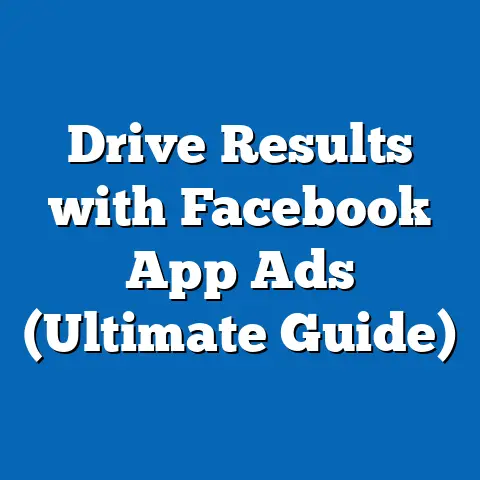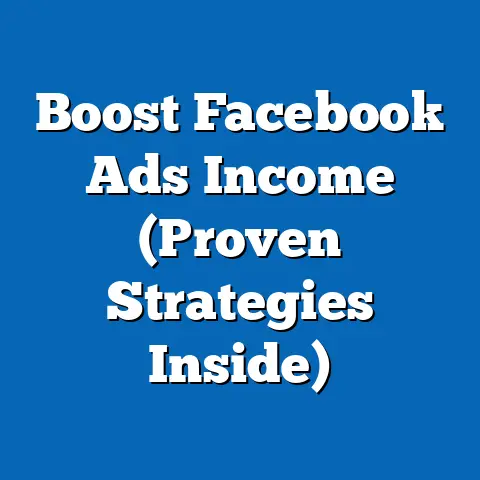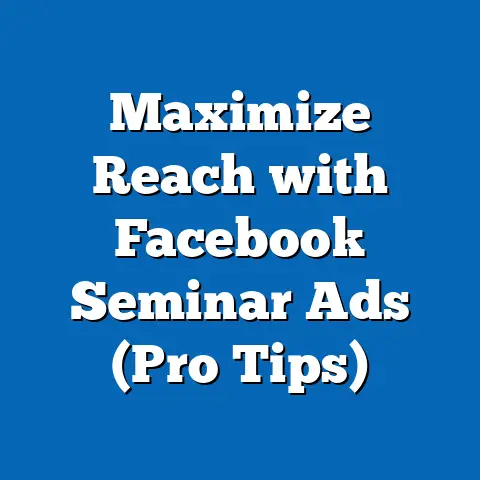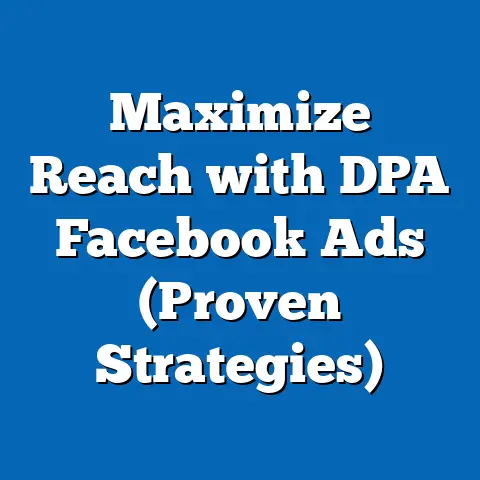Boost Nonprofit’s Reach with Free Facebook Ads (Effective Strategies)
Imagine a small, local animal shelter, bursting with love and dedication but struggling to keep the lights on. They have a team of passionate volunteers, a handful of loyal donors, and a never-ending stream of furry friends needing homes. Their biggest challenge? Getting their message out to the community. They dream of reaching more potential adopters, securing more donations, and ultimately, giving every animal a second chance. But with a shoestring budget and limited marketing expertise, their reach feels frustratingly limited.
This is a story I’ve seen play out time and time again. Nonprofits, the heart and soul of our communities, often face a monumental challenge: how to amplify their message and impact without breaking the bank. That’s where Facebook Ads can be a true game-changer.
I remember working with a small environmental conservation group a few years back. They were doing incredible work protecting local wetlands, but their online presence was almost nonexistent. We helped them apply for and utilize Facebook’s free ad credits. The results were astounding. Within weeks, they saw a 300% increase in website traffic, a surge in volunteer applications, and a significant boost in online donations. Their message, once a whisper, was now a resounding call to action.
This article isn’t just about the technicalities of Facebook Ads; it’s about empowering nonprofits to amplify their mission, connect with their communities, and create transformative change. With the right strategies and a bit of creativity, even organizations with limited resources can achieve substantial outreach and impact. So, let’s dive into how you can boost your nonprofit’s reach with free Facebook Ads!
Understanding Facebook Ads for Nonprofits
Let’s start with the basics. What exactly are Facebook Ads, and how can they specifically benefit nonprofits?
Facebook Ads are paid messages that businesses and organizations can display on Facebook, Instagram, and the Audience Network. Unlike organic posts, which rely on your followers and Facebook’s algorithm to determine reach, ads are designed to target specific audiences based on demographics, interests, behaviors, and more. This targeted approach is particularly powerful for nonprofits because it allows them to connect with individuals who are most likely to support their cause.
Think of it this way: instead of shouting your message into the void and hoping someone hears it, Facebook Ads allow you to hand-deliver your message to the people who are already interested in what you’re doing.
Benefits of Using Facebook Ads for Nonprofits:
- Targeting Capabilities: This is arguably the biggest advantage. I’ve seen nonprofits use Facebook’s targeting options to reach specific demographics, like young professionals interested in environmental issues, or families with young children who might be interested in sponsoring a child in need.
- Cost-Effectiveness: Compared to traditional advertising methods like print or television, Facebook Ads can be incredibly cost-effective. You can set a daily or lifetime budget and only pay when people see or interact with your ad. And, as we’ll discuss later, many nonprofits are eligible for free ad credits.
- Global Reach: Facebook boasts billions of active users worldwide. This means you can potentially reach a global audience and connect with supporters from all corners of the planet. This is particularly beneficial for international nonprofits or those working on global issues.
- Measurable Results: Facebook Ads Manager provides detailed analytics, allowing you to track the performance of your campaigns and see exactly how your ads are performing. This data-driven approach allows you to optimize your campaigns for better results.
- Versatile Ad Formats: From compelling image ads to engaging video ads and interactive lead generation forms, Facebook offers a variety of ad formats to suit different objectives and audiences.
Free Ad Credits for Eligible Nonprofits:
Now, for the exciting part! Facebook offers ad credits to eligible nonprofits through its various programs, including the Meta Nonprofit Grants Program. This is a fantastic opportunity to access free advertising and amplify your message without dipping into your limited budget.
Here’s what you need to know about applying for free ad credits:
- Eligibility: Check the eligibility criteria on the Meta for Nonprofits website. Typically, you’ll need to be a registered nonprofit organization with a valid tax ID.
- Application Process: The application process usually involves providing information about your organization, its mission, and how you plan to use the ad credits.
- Compliance: Ensure you understand and comply with Facebook’s advertising policies and guidelines. Noncompliance can result in your ads being disapproved or your account being suspended.
Important Tip: Don’t underestimate the importance of understanding Facebook’s policies and guidelines. I’ve seen nonprofits get their accounts suspended for inadvertently violating a policy, which can be a major setback. Take the time to read the fine print and ensure your ads are compliant.
Key Takeaway: Facebook Ads offer a powerful and cost-effective way for nonprofits to reach their target audiences and amplify their message. Take advantage of available ad credits and always comply with Facebook’s policies.
Setting Clear Objectives
Before you even think about creating an ad, it’s crucial to define your objectives. What do you want to achieve with your Facebook Ads campaign? Are you aiming to increase event registrations, boost donations, raise awareness for a specific cause, or something else entirely?
Setting clear objectives is essential for several reasons:
- It provides direction: Objectives give your campaign a clear focus and help you stay on track.
- It informs your strategy: Your objectives will influence your targeting, ad creative, and budget allocation.
- It allows you to measure success: Without clear objectives, you won’t be able to determine whether your campaign was successful.
The Power of SMART Objectives:
I’m a big advocate for using the SMART framework to define your objectives. SMART stands for:
- Specific: Your objective should be clear and well-defined. Avoid vague goals like “increase awareness.” Instead, aim for something like “increase website traffic by 20%.”
- Measurable: You should be able to track your progress and measure your results. This means using quantifiable metrics like website traffic, donation amounts, or event registrations.
- Achievable: Your objective should be realistic and attainable given your resources and budget. Don’t set yourself up for failure by aiming for unrealistic goals.
- Relevant: Your objective should align with your overall mission and goals as a nonprofit. Ensure your ad campaign is contributing to your broader organizational objectives.
- Time-bound: Set a specific timeframe for achieving your objective. This will help you stay accountable and track your progress over time.
Examples of SMART Objectives for Nonprofits:
- Increase Event Registrations: “Increase registrations for our annual fundraising gala by 15% within the next 30 days.”
- Boost Donations: “Increase online donations by 10% during our end-of-year giving campaign.”
- Raise Awareness: “Increase reach on Facebook by 25% to raise awareness about our new program for homeless youth within the next 60 days.”
Aligning Ad Strategy with Your Mission:
It’s crucial to remember that your ad strategy should always be aligned with your overall mission and goals as a nonprofit. Your ads should reflect your values, communicate your impact, and inspire people to support your cause.
I’ve seen nonprofits make the mistake of focusing solely on the technical aspects of Facebook Ads and neglecting the importance of aligning their ads with their mission. This can result in ads that are ineffective or even damaging to their reputation.
Key Takeaway: Setting clear, SMART objectives is crucial for the success of your Facebook Ads campaign. Ensure your objectives are aligned with your overall mission and goals as a nonprofit.
Crafting Compelling Ad Content
Now that you’ve defined your objectives, it’s time to create compelling ad content that will grab attention, resonate with your target audience, and inspire them to take action. This is where your creativity and storytelling skills come into play.
Elements of Effective Ad Copy:
- Catchy Headlines: Your headline is the first thing people will see, so it needs to be attention-grabbing and relevant to your audience. Use strong verbs, ask questions, or highlight a key benefit.
- Persuasive Descriptions: Your description should provide more detail about your organization, your cause, and what you’re asking people to do. Use clear and concise language, and focus on the impact of their support.
- Clear Calls to Action: Tell people exactly what you want them to do. Use strong calls to action like “Donate Now,” “Learn More,” “Volunteer Today,” or “Sign Up.”
Telling a Compelling Story:
People are more likely to connect with a story than with a list of facts and figures. Use your ads to tell a compelling story about your organization, the people you serve, and the impact you’re making.
I remember working with a nonprofit that provided clean water to communities in developing countries. Instead of simply stating that they provided clean water, they shared the story of a young girl who was able to attend school because she no longer had to spend hours each day collecting water. This story resonated deeply with their audience and resulted in a significant increase in donations.
Visuals That Resonate:
Visuals are just as important as your ad copy. Use high-quality images or videos that capture the essence of your organization and your cause. Choose visuals that are emotionally compelling, visually appealing, and relevant to your target audience.
Examples of Successful Ad Content:
Let’s look at some examples of successful ad content from nonprofits and analyze what made them effective:
- Example 1: Charity: Water: Their ads often feature stunning images of the communities they serve and highlight the impact of clean water on people’s lives. They use strong calls to action like “Give Clean Water” and “Change a Life.”
- Example 2: The Nature Conservancy: Their ads often feature breathtaking images of natural landscapes and highlight the importance of conservation. They use persuasive copy that emphasizes the benefits of protecting our planet.
- Example 3: Doctors Without Borders: Their ads often feature powerful stories of their medical professionals working on the front lines of humanitarian crises. They use clear calls to action like “Donate Now” and “Support Our Work.”
A/B Testing for Optimal Results:
Don’t be afraid to experiment with different ad creatives. A/B testing allows you to test different headlines, descriptions, visuals, and calls to action to determine which resonates best with your audience.
I always recommend that nonprofits start with a few different ad variations and then track their performance closely. This will help you identify the winning combinations and optimize your campaigns for better results.
Key Takeaway: Crafting compelling ad content is essential for capturing attention, resonating with your audience, and inspiring them to take action. Use strong visuals, tell compelling stories, and A/B test different ad creatives to optimize your results.
Audience Targeting Strategies
One of the most powerful features of Facebook Ads is its advanced targeting capabilities. You can target your ads to specific audiences based on a wide range of factors, including demographics, interests, behaviors, and custom audiences.
Understanding Targeting Options:
- Demographics: Target your ads based on age, gender, location, education, and other demographic factors.
- Interests: Target your ads based on people’s interests, hobbies, and passions. For example, you could target people who are interested in environmental issues, animal welfare, or social justice.
- Behaviors: Target your ads based on people’s behaviors, such as their purchase history, online activity, and device usage.
- Custom Audiences: Create custom audiences based on your existing contacts, website visitors, or app users. This allows you to target your ads to people who are already familiar with your organization.
- Lookalike Audiences: Create lookalike audiences based on your existing custom audiences. This allows you to reach new potential supporters who share similar traits with your existing ones.
Segmenting Your Audience:
It’s important to segment your audience based on their relationship with your nonprofit. For example, you might create separate audiences for:
- Past Donors: Target these individuals with ads that thank them for their past support and encourage them to donate again.
- Volunteers: Target these individuals with ads that highlight upcoming volunteer opportunities.
- Community Members: Target these individuals with ads that raise awareness about your organization and its mission.
The Value of Lookalike Audiences:
Lookalike audiences are a powerful tool for expanding your reach and connecting with new potential supporters. Facebook uses its algorithms to identify people who share similar traits with your existing customers or supporters.
I’ve seen nonprofits use lookalike audiences to significantly increase their reach and generate new leads. For example, a nonprofit that provides mentoring services to at-risk youth created a lookalike audience based on their existing donors. This resulted in a significant increase in online donations from new supporters.
Strategic Insights:
- Start with your ideal supporter: Define your ideal supporter and then use Facebook’s targeting options to reach people who fit that profile.
- Test different audiences: Don’t be afraid to experiment with different targeting options to see what works best.
- Use custom audiences strategically: Use custom audiences to re-engage with your existing supporters and build stronger relationships.
- Leverage lookalike audiences: Use lookalike audiences to expand your reach and connect with new potential supporters.
Key Takeaway: Effective audience targeting is crucial for reaching the right people with the right message. Segment your audience based on their relationship with your nonprofit, and leverage lookalike audiences to expand your reach.
Analyzing and Optimizing Campaigns
Once your ads are running, it’s crucial to monitor their performance and optimize them for better results. This involves tracking key metrics, analyzing the data, and making adjustments to your campaigns as needed.
Monitoring Ad Performance:
Facebook Ads Manager provides a wealth of data about your ad performance. Some of the key metrics that nonprofits should focus on include:
- Reach: The number of people who saw your ad.
- Impressions: The number of times your ad was displayed.
- Engagement: The number of likes, comments, shares, and clicks your ad received.
- Website Traffic: The number of people who clicked on your ad and visited your website.
- Conversion Rates: The percentage of people who completed a desired action, such as making a donation or registering for an event.
- Cost Per Result: The average cost you paid for each desired result, such as a website visit or a donation.
Using Facebook Ads Manager:
Facebook Ads Manager is your central hub for managing and analyzing your ad campaigns. It allows you to track your performance, view detailed reports, and make adjustments to your targeting, budget, and ad creative.
I encourage nonprofits to spend time familiarizing themselves with Facebook Ads Manager and learning how to use its various features. There are many online tutorials and resources available to help you get started.
Being Agile and Adaptive:
The key to successful Facebook advertising is being agile and willing to adjust your strategies based on performance data. Don’t be afraid to experiment with different targeting options, ad creatives, and bidding strategies to see what works best.
I’ve seen nonprofits make the mistake of setting up their campaigns and then leaving them to run without monitoring their performance. This can result in wasted ad spend and missed opportunities.
Examples of Campaign Adaptations:
- A nonprofit running an ad campaign to promote an upcoming fundraising event noticed that their click-through rate was low. They decided to change their ad creative and use a more compelling image. This resulted in a significant increase in click-through rates and event registrations.
- A nonprofit running an ad campaign to raise awareness about a specific cause noticed that their cost per result was high. They decided to narrow their targeting to focus on a more specific audience. This resulted in a lower cost per result and a more efficient use of their ad budget.
Key Takeaway: Monitoring ad performance and optimizing your campaigns is crucial for achieving your objectives. Use Facebook Ads Manager to track your progress, analyze the data, and make adjustments to your strategies as needed.
Conclusion
Facebook Ads can be a transformative tool for nonprofits, empowering them to amplify their mission, connect with their communities, and create meaningful change. I’ve witnessed firsthand the incredible impact that well-executed Facebook Ads campaigns can have on organizations of all sizes.
I’ve seen nonprofits go from struggling to reach their target audience to experiencing a surge in donations, volunteer applications, and overall engagement. The key is to approach Facebook Ads with a strategic mindset, a creative spirit, and a willingness to learn and adapt.
Key Reminders:
- Set clear objectives: Define what you want to achieve with your campaign and use the SMART framework to ensure your objectives are specific, measurable, achievable, relevant, and time-bound.
- Craft compelling ad content: Use strong visuals, tell compelling stories, and A/B test different ad creatives to optimize your results.
- Target your audience effectively: Segment your audience based on their relationship with your nonprofit, and leverage lookalike audiences to expand your reach.
- Monitor and optimize your campaigns: Use Facebook Ads Manager to track your performance, analyze the data, and make adjustments to your strategies as needed.
- Remember your mission: Ensure your ad strategy is always aligned with your overall mission and goals as a nonprofit.
Call to Action:
The resources to amplify your mission are at your fingertips. Take action today by applying the strategies discussed in this article and harnessing the potential of free Facebook Ads to bring about meaningful change in your community. Whether you’re raising awareness about a critical issue, seeking volunteers for an upcoming event, or soliciting donations to support your programs, Facebook Ads can help you reach the right people and make a real difference.
Don’t let limited resources hold you back from achieving your goals. Embrace the power of Facebook Ads and let your message resonate with the world.






